Two French papermakers from Annonay near Lyons, Joseph
and Etiennne Montgolfier first demonstrated their experiments with
hot air balloon flight in June 1783. Constructed of paper-lined
linen, the unmanned balloon obtained lift from hot air, which rises
because it is slightly less dense than cold air. Buming straw, wool
and various odd substances in a basket slung beneath the open
base of the bat loon envelope produced the heat..
Initially, the Montgolfiers did not appreciate why their invention
had worked, thinking the combination of materials in their fire had
produced a lighter-than-air gas. The problem with hot air balloons is
that the difference between the densities of hot and cold air is not
that great. A large balloon envelope would be required to lift the fire,
passengers and ballast.
In the same year, French physicist Jacques Charles invented
the gas balloon. His balloon, the 'Charlieres', used hydrogen (the
lightest element, discovered in 1766) to lift a sealed envelope. This
had an outer cover to which to a gondola was attached by lines. The
first model was just 12ft in diameter. Unmanned, in three-quarters of
an hour it flew 15 miles before landing near a remote village.
Pitchforks in hand, the local peasants ran out to attack what they
believed to be some devil-created machine.
First Passengers
Two months later, on 21 November, Pilatre de Rozier and the Marquis d'Arlandes rose from the gardens of La Muette, near Paris, to make the first manned flight. The balloon, open at the base of the envelope like modern leisure balloons, had a platform slung beneath it. In the middle of this platform burned a fire to heat the air, which they now appreciated to be the source of the balloon's 'lift'.
The passengers were in a circular gallery fitted around the
platform. The flames from an auxiliary brazier got fierce as the Marquis replenished it with straw bundles until a few cinders struck the balloon, which began to smoulder. Fortunately, the two aeronauts were prepared for this and doused the flames with wet sponges. Half an hour
and 6 miles later, they landed.
The inherent dangers of the hot-air design were obvious and
it was to be Charles' design that became pre-eminent and developed
into the first military balloons. Just a fortnight after de Rozier's flight,
Charles and a Monsieur Robert took to the air in a hydrogen balloon,
flying 27 miles before Charles dropped Robert off and ascended
again.
Although he never flew again, Charles began experimenting
with vents for better vertical control and other suggestions were put
forward for steering a balloon in flight.
In January 1785, a hydrogen-filled balloon carried Jean-Pierre
Blanchard and Dr. John Jefferies from Dover to Calais in the first air
crossing of the Channel. De Rozier meanwhile, continued his own
experiments. One of these was an attempt to mix air with the highly
flammable hydrogen gas. His airship consisted of a cylindrical hot-air
envelope with a spherical gas container above.
First Casualty
The purpose of this combination was to remove the need for
ballast: The hydrogen would keep the balloon aloft, while its height
could be varied by heating the air. He also planned to cross the
Channel, but perhaps inevitably, during the trials the craft exploded
into flames. De Rozier was thus both the first aeronaut and the first
victim of air travel.
While this incident discouraged many, an Italian Count
Zambeccari tried to refine the hot air design by heating the air in
the envelope with a heater fuelled by spirit. This was an early
version of the gas burner seen on modern balloons. Setting out on
one flight, the balloon became entangled in a tree, causing the hot
spirit to spill over the pilot, setting light to his clothes.
However, the sudden burst of flame lifted the balloon clear of
the tree and Zambeccari managed to extinguish the flames and
descend safely. For the next decade, the dangers of ballooning
restricted it to being a popular toy.
At the end of the 1780s, the first extensive technical
investigations were being conducted by General Meusnier, who
wrote the 'First Great Technical Manual of Aeronautics'. This did not
contain any references to military applications. He would not see
the start of military ballooning as he died on 13 June 1793, just
as the Convention in Paris approved an idea of balloons being used
for reconnaissance. This was put forward by a Chemist of the Dijon
Academy, Guyton de Morveau. An eight-man commission, whose
members included Carnot. was established to consider the idea
more carefully.
Steering
The real problem with balloons was that they could
not be controlled sufficiently in flight for effective
reconnaissance. Vincent Lunardi, who had made the first
flights in England, used oars in an effort to control the
direction of flight, but to no avail. Blanchard's cross-Channel
balloon had carried wings, which proved equally useless.
The most bizarre idea came from Kaiserer, who in 1801,
suggested tethering a team of eagles to the balloon.
However, as the first balloons took to the air, the basis of a solution
was provided by Jean Baptiste Meusnier, who in 1784 produced the first design for a dirigible, (a steerable airship). This utilised a balloon shape similar to the familiar flattened cigar with pointed ends, propellers for power and a rudder. Although it was never built and human power for the propellers would have only moved it at a very slow speed, it bears a close resemblance to the airships of the early 20th century.
On 26 July 1793 Guyton officially informed the committee that he
had constructed a test balloon, based on an example found in the
confiscated property of the Emigre, L'Allemand-Saint-Croix. Further
efforts were made to provide a steering mechanism and the first
trial for Morveau's ideas was conducted at the siege of Conde in
the summer of 1793. A small untethered 'pilot balloon' was deployed
to overfly enemy positions carrying messages.
However, the material used for the envelope was not thick
enough and the balloon deflated, sinking behind enemy lines into the
hands of the Allied commander, Coburg. It carried a pigeon for the
return flight, which was duly consumed by allied soldiers. It was
thus concluded that only a tethered balloon was feasible and further
tests were conducted on this basis, despite the disadvantage of
observers having to look at enemy lines from a distance.
Still keen to push their alternative free-flying design, at the
end of 1793 one of the Montgolfiers proposed that a large balloon be
constructed. This would carry a 30-ton explosive which could then
be dropped on the besieged port of Toulon.
Manufacture
Although that idea was rejected, doubts continued over
the hydrogen balloon. Charles had shown that hydrogen was the
best gas because it is the lightest element. The main technical
problem to be overcome before the balloon could enter service
was filling the huge envelope with hydrogen.
The sulphuric acid (required to separate water into its
constituent elements of hydrogen and oxygen) was in very short
supply. Sulphur was rare in France and was usually requisitioned
for the manufacture of gunpowder. However, Lavoisier's
discovery that water could be separated using red-hot iron came to
Guyton's rescue, particularly as it made large-scale production
feasible.
After gaining government approval, the Paris physicist Jean
Coutelle was authorised to conduct the project. Working with the
famous technician, Conte, he refined the process so that a
balloon was filled in front of the commission at the Tuillieres in Paris.
The hydrogen was produced in a brick oven, in which a cast iron tube, measuring 1 metre by 30cm diameter within 30mm thick metal. This was filled with scrap metal, nails and iron filings and was heated until it glowed red hot. At both ends, which tapered into a smaller rounded shape, were fixed small pieces of sheet iron, later copper tubing. At one end, water was poured into the small tube and conducted through the pipe system across the glowing irons while,
at the other end, the hydrogen was collected as it boiled off.
Further trials went well and on 25 October, the Committee For
Public Safety, (the Revolutionary government), ordered the
construction of a fixed balloon and gondola to lift two men,
observation equipment and ballast.
Armee Du Nord
The first balloon was to go as quickly as possible to the
Armee du Nord, while St. Croix's old balloon was also repaired and
refurbished. In the meantime, Guyton had developed a manual for the
use of balloons, including a signalling system. This system, which
was used throughout their existence by the balloon companies,
consisted of a series of light signals and red, yellow and green flags.
Notes could also be dropped in weighted bags but, at low
altitudes, a 'voice tubes was used. By combining signals and firing
shots from the ground, two-way communication could be used - for
example: 4 shots meant that 'The garrison will make a foray'.
Four balloons, each with an envelope 10m in diameter, were
constructed of varnished silk. Each was covered with a restraining
net, from which a basket was slung. The balloons were named the
Entreprenant, the Celeste, the Telemarque and the Intrepide.
The problem with the envelope's material strength was also
addressed by the application of linseed oil to reinforce the
fabric. At the base of the balloon envelope, a tie-pull rope was
attached for the release of gas to allow the balloon to descend.
By now, it was the end of the campaigning season and bad
weather was closing in. Combined with the heavy expense, the
National Assembly's Political Commissar attached to the Nord took the
view that the idea was silly and threatened to have Coutelle
shot. Quite naturally in the political climate of 'The Terror', Coutelle
rushed back to Paris to stop the balloon's transport.
The French government however decided to pursue the
project. St. Croix's balloon was sent for further tests at Meudon,
(southwest of Paris), where a research facility had been authorised
to experiment with pyrotechnics and experimental weaponry. The
now Captains Coutelle and Lhomond, later joined by Conte, were
authorised to establish the first 'aeronautical Test Station'.
Work continued on tests of materials and gas production all
through the winter of 1793-4. On the 27 March, St. Croix's balloon,
now the Empreveur, was filled with 350 m3 of gas, a process that
took 10 hours. Two days later, it flew for the first time. Coutelle
went up in person to a height above 1500 ft and gave an
enthusiastic report about the view he had.
Tests at Meudon showed that on a clear day at about 500m,
(1600 ft.), with a telescope, it was possible to see in detail terrain
features and troops at 9-10 kms. At 17-22 kms, it was still possible to
see clouds of smoke and the general lines of the terrain. As a
result, the Premiere Compagnie d'Aerostiers Militaire (1 st
Military Airship Company) was formed, expected to comprise a
Captain, a Lieutenant, a Sergeant-Major, a Sergeant, 2 Corporals
and 20 men, without exception all skilled artisans.
Uniforms
Their uniforms were blue shirts and trousers, black
cuffs with red piping, wrth infantry buttons imprinted with
'Aerostiers'. They wore tricornes and were armed with a short
sabre and two pistols. They also had a workcoat made of blue or
bleached twill cloth. Officially, as skilled men, they had the status of
engineers.
Further trials at Meudon showed once inflated a balloon could
stay usable for up to two months before requiring replacement gas,
but the actual production of the hydrogen gas remained a torturous
process.
A brick oven had to be constructed, in which 7 cast-iron
tubes were placed. These were filled with iron filings and scrap iron
free of rust, four on the bottom and three on top, tapered off at each
end to narrow copper pipes. More bricks were then used to close off
the oven. At one end, an upturned water tub poured water down
the small feeder pipes into the main tubes. The oven was heated up
with charcoal until the rods glowed red hot.
The hydrogen boiled off and the pressure forced the
water into a second square tub at the other end, which was filled
with saturated slaked lime solution. The gas streamed through this
solution and was then purified by passing it through a carbon
filter to extract any oxygen impurity. The pressure then
pushed it on through a rubber tube into the balloon at the
other end, which steadily inflated as the gas entered.
The extraction of enough hydrogen gas (524 m3) from
water to inflate the balloon was a slow process. The fire had to act
equally on all the rods, with great care having to be taken that there
was no cracking or swelling, otherwise no gas would be produced.
If the gas was escaping a blue flame became visible, which then
had to be plugged - a tricky business when the whole apparatus
was red-hot. The actual inflation could take 36-40 hours, during
which time the equipment could not be left unattended. The biggest
problem was therefore that a deflated balloon could probably not be
inflated and deployed at a battle site before the fighting was finished.
The support train comprised nine heavy four-horse
transports, including the two equipment-wagons and a baggage cart.
It hauled seven cast iron tubes, a number of barrels full of scrap iron
and a heavy balloon cover, a total weight of 17,000 pounds.
The balloon could easily carry two people and 120-140
pounds of ballast - sand or earth in linen or canvas sacks. Lines
attached the gondola to the securing net strung over the top of the
balloon envelope, to which two stouter lines were also attached to
connect the balloon with the ground team. These ropes were roughly
400m long and could if necessary be extended to 1800m.
The French balloon finally made its way to war in mid-1794
with Coutelle now formally appointed to the command of the 1 st
Company. Under-strength at just 26 officers and men, who had
received little training, they reached Mauberge, near the border with
the Austrian Netherlands (Belgium), with the 'Entreprenant' on 6 May
1794.
A gas kiln was built and the balloon inflated, the process
taking 50 hours. For the next three weeks, a few trial ascents were
made. Then at about 7.00 p.m. on 2 June, 'Entreprenant' rose for its
first proper flight to 350m above Mauberge, from where its two
crew were able to give an extensive report on the troop positions
around the city.
The Austrians thought at first that this was a student prank,
but noted the crew could be seen using a red and a white
(presumably yellow) flag. Technical work meant that the balloon
was not available for use at the following day's battle at Gosselies,
as it was not possible to move it at least some of the 39 km from
Mauberge.
Two Flights Day
Nevertheless, from 3 to 21 June, there were usually two
flights a day in the area, the balloon always on tethered lines,
including during the first clash at Fleurus on the 16th. Later, from the
20th onwards, its crew could observe the advancing Austrian
columns as Coburg mounted his counter-attack. The balloon's
effectiveness was however greatly reduced by its being positioned
too far from the fighting.
The problem was not helped by the observers' lack of
experience, especially when the balloon basket both swayed and
wobbled vertically in the wind. Military aviation was also rapidly
becoming dangerous - on the 13th, an Austrian battery tried to
open fire on the balloon.
This occurred every subsequent day with 4 pounders
turned on it. As the 'Entreprenant' ascended to 200m on the 21st,
Austrian fire reached to within 40m, but the balloon ascended farther
to gain protection in the fog. Although the balloon was never hit, this
high angle fire was more worrying for the men on the ground holding
the lines, as the cannonballs returned to earth.
The real problem was bad weather, which one time
dragged the 'Entreprenant' on to the church tower at Mauberge,
where it suffered minor damage as a result. The gas oven also
suffered problems with some of the retort external tubing melting,
causing major delays in gas production. On the 21st, General Jourdan,
commanding the Sambre-Meuse Army ordered Coutelle's company
towards Fleurus, some 30 miles (50 km) away, where he expected
to clash with the Imperial army again in the next few days.
Dispatched to Charleroi, 34 km away, the balloon had to be
moved in a fully inflated state because Jourdan needed news from
that sector as soon as possible.
Crossing Obstacles
Accompanied by a cavalry escort, it set off tethered to a
horsedrawn wagon, but the first problem was to pass through the
city gate of Mauberge. Guyton proposed to cross the wall at night.
He would abandon the cart and tie the ropes from the balloon to the
20 mounted men who formed the escort, leaving a man aboard to
control the ballast.
By gradually transferring the ropes from the cart to the
cavalrymen, the obstacle was passed and the march continued
through the night of 22nd-23rd. The balloon maintained at a height
such that cavalry and transports could pass beneath it. The effect of
this on the horses is not recorded.
The 'Entreprenant' reached Charleroi the following
day, the 25th, just as the fortress was captured from the Allies.
It was aloft on 26 June 1794 throughout most of the battle of Fleurus
from 6.00 a.m. to 4.00 p.m. In the first use of aviation in battle,
Coutelle was in the gon dola during the fighting supplying
information, which is said to have assisted Jourdan to defeat the
Austrians.
Unfortunately, the reports about its effectiveness in
confirming Austrian movements were later lost, but Jourdan's later
report in 1799 was instrumental in leading to the disbandment of the
force. Soult and Championnet also said it served no real purpose,
although it may have caused some consternation in the Austrian
ranks.
Much of the fighting led by the Austrian left under
Archduke Charles and Beaulieu took place around Charleroi
in broken terrain where the actual army lines flowed continuously.
The reason why the French won the battle of Fleurus was largely
due the nerve of the Allied commander, Coburg, failing at the crucial
moment, not that Jourdan derived some intelligence advantage
from his balloon.
On 5 July, after 27 flights and suffering from the heat and
several rainstorms, the balloon was greatly weakened and suffered
heavy damage in a storm. All these flights had been on the original
gas, which was gradually seeping out of the envelope, so it was
sent back to Mauberge for repair.
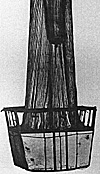 War breeds rapid technical advance and the Revolutionary Napoleonic period was no exception. One example can be found in the French Wars section of the Army History Museum in Vienna. Here, in one corner, is a French balloon. As far as I am aware, it is the only surviving example of the first military aviation. It was not however the first victim of antiaircraft fire. Rather, this balloon was captured following Archduke Charles' decisive victory over General Jourdan on 3 September 1796 at Wurzburg in central Germany. It was found in a deflated state in a French depot in the nearby castle.
War breeds rapid technical advance and the Revolutionary Napoleonic period was no exception. One example can be found in the French Wars section of the Army History Museum in Vienna. Here, in one corner, is a French balloon. As far as I am aware, it is the only surviving example of the first military aviation. It was not however the first victim of antiaircraft fire. Rather, this balloon was captured following Archduke Charles' decisive victory over General Jourdan on 3 September 1796 at Wurzburg in central Germany. It was found in a deflated state in a French depot in the nearby castle.
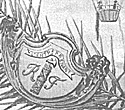 1994 marked the 200th anniversary of the formation of the first military aviation
unit, the Premiere Compagnie d'Aerostiers Militaire and the first use of balloons by
the French in action. Mainly condensed from 'Die Anfange der Militarluftschiffahrt und ihre
erste Anwendung im Feldzug 1794', (which summarised most of the available German and
French literature), and various general reference books, this article looks at the development
of early military aviation. For wargamers, use of balloons could be a partial justification for
the infamous 'helicopter' viewpoint of the table.
1994 marked the 200th anniversary of the formation of the first military aviation
unit, the Premiere Compagnie d'Aerostiers Militaire and the first use of balloons by
the French in action. Mainly condensed from 'Die Anfange der Militarluftschiffahrt und ihre
erste Anwendung im Feldzug 1794', (which summarised most of the available German and
French literature), and various general reference books, this article looks at the development
of early military aviation. For wargamers, use of balloons could be a partial justification for
the infamous 'helicopter' viewpoint of the table.
Early Experiments
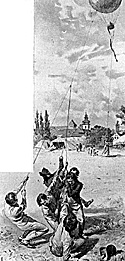 Not to be outdone, the Montgolfiers continued their
experiments. That September at Versailles, a duck, a rooster and a
sheep were sent aloft to see if the rarefied air would harm them. The
only damage was to the rooster's wing, which was probably kicked
by the sheep.
Not to be outdone, the Montgolfiers continued their
experiments. That September at Versailles, a duck, a rooster and a
sheep were sent aloft to see if the rarefied air would harm them. The
only damage was to the rooster's wing, which was probably kicked
by the sheep.
Guyton's Balloons
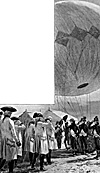 Back in the real world, Guyton therefore proposed the use of a
balloon tethered by lines to the ground. This not only controlled the
balloon, but largely prevented the natural tendency of a spherical
balloon to spin in flight. Interior Minister Gartat came up with the
necessary money and materials.
Back in the real world, Guyton therefore proposed the use of a
balloon tethered by lines to the ground. This not only controlled the
balloon, but largely prevented the natural tendency of a spherical
balloon to spin in flight. Interior Minister Gartat came up with the
necessary money and materials.
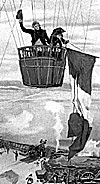 In October 1793, the balloon sent to the Armee du Nord was
intended to be deployed in the relief of Mauberge, then besieged by
Allied armies. Coutelle was sent on ahead to prepare the requisite
gas-producing ovens and other materials, as well as informing
Jourdan of the balloon's despatch.
In October 1793, the balloon sent to the Armee du Nord was
intended to be deployed in the relief of Mauberge, then besieged by
Allied armies. Coutelle was sent on ahead to prepare the requisite
gas-producing ovens and other materials, as well as informing
Jourdan of the balloon's despatch.
The Meudon Base
Back to Age of Napoleon No. 22 Table of Contents
Back to Age of Napoleon List of Issues
Back to MagWeb Master List of Magazines
© Copyright 1997 by Partizan Press.
This article appears in MagWeb (Magazine Web) on the Internet World Wide Web.
Other military history articles and gaming articles are available at http://www.magweb.com